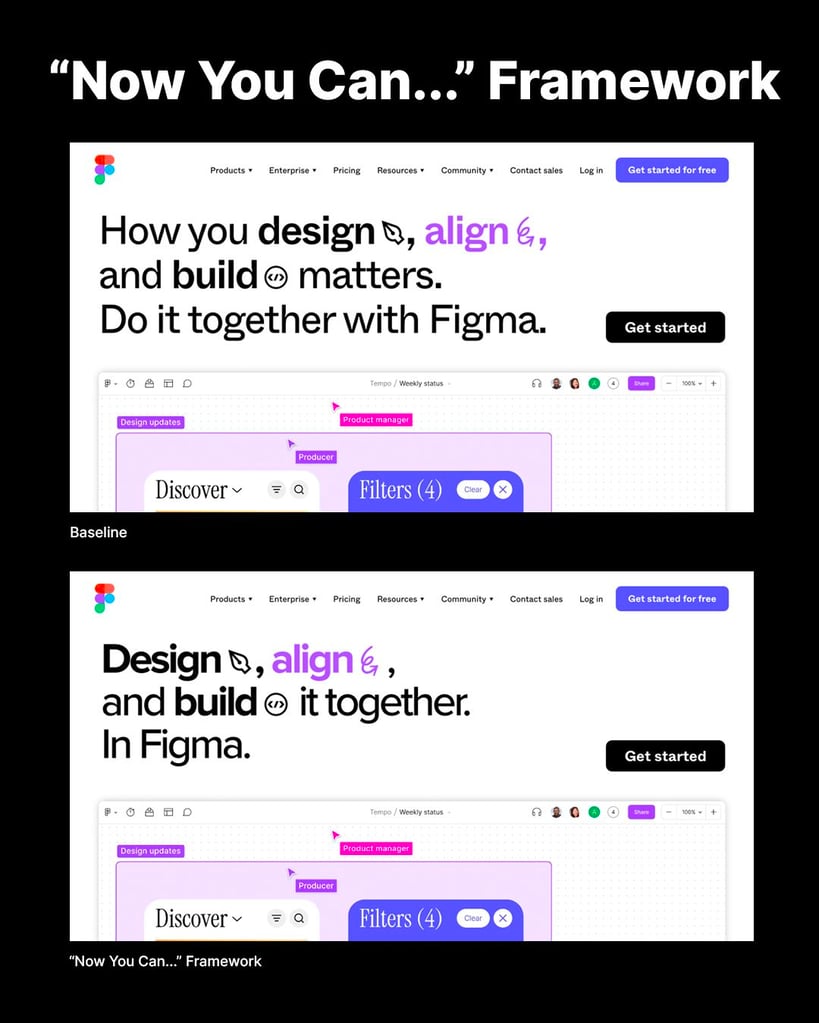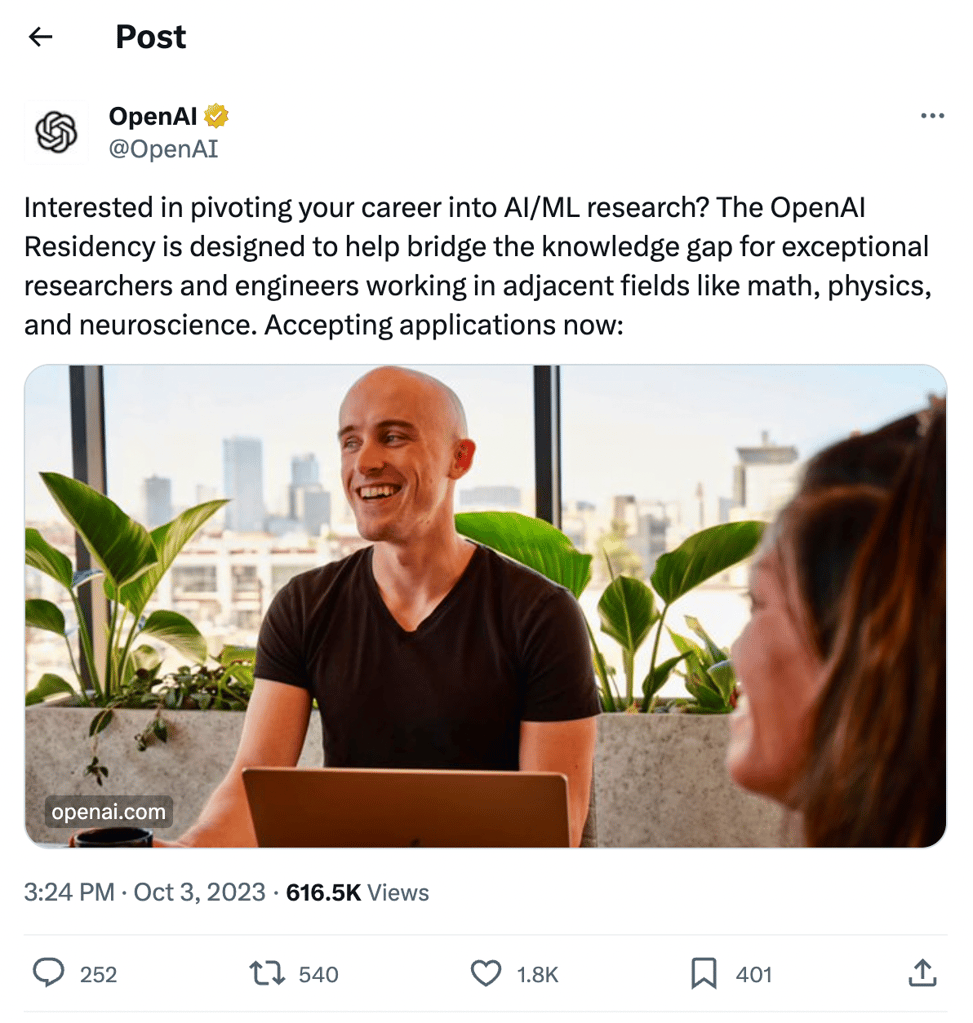Hey there! Have you ever wondered how to elevate your written content from good to absolutely stunning? Welcome to the exciting world of copy testing! We are Inspired by Neal O’Grady 🍉‘s 10 key recommendations for copy enhancement.

Test data from millions of Helio test participants has revealed a consistent truth: optimizing your page’s copy is a reliable method to elevate key metrics, be it engagement or conversion. We’ve observed straightforward modifications in copy can result in a remarkable 10-15 point increase in overall performance. Here are our top three recommendations from Neal for creating more clarity in your screens:
- Cut the Fluff: Remove any word that doesn’t add value, especially in introductions to hook the reader’s interest.
- Be Specific: Spell out details clearly, making it easy for the reader to picture what they’re getting.
- Use Simple Words: Don’t use complex words when simpler ones will suffice. Pretend you’re explaining to a 10-year-old.
Great copy isn’t just about stringing words together; it’s about shaping them to resonate deeply with your audience. Let’s unpack the secrets of copy testing and transform your writing into a compelling force!
What is Copy Testing?
At its heart, copy testing is your content’s trial run. It’s a systematic approach to assessing and refining your marketing copy, based on concrete feedback and performance data. Think of it as giving your words a test drive before they zoom into the market.
Picture launching a campaign that flops – a marketer’s nightmare, right? Copy testing is your safeguard against this. By aligning your message with your audience’s needs and tastes, you dramatically increase the chances of your copy striking the right chord. It’s what separates the hits from the misses.
- Know Your Audience Inside Out- The first step in copy testing is like stepping into your audience’s shoes. What are their desires, needs, and language styles? This insight is crucial for creating copy that truly connects.
- Crafting Your Message- Armed with audience knowledge, it’s time to sculpt your message. Your mantra here: be clear, be concise, and above all, be captivating. Remember, every word has weight!
- The Magic of Testing- The real fun begins with concept testing. Whip up two versions of your copy and let them compete. This head-to-head showdown offers invaluable insights into your audience’s preferences.
- Tuning in to Feedback- Feedback is your treasure trove. Dive deep into how your audience reacts to your copy. What elements are they loving? What’s not hitting the mark? Use these insights as your guide to refine and enhance your words.
- The Art of Refinement- Copy testing is all about evolution. Continuously hone your copy based on the feedback and data you gather. Each revision brings you closer to that sweet spot of perfection.
Best Practices for Knockout Copy Testing
When you’re testing your copy, always remember this: keep it super clear. Use words that everyone gets right off the bat. The best kind of writing is the sort that just clicks without making your brain do gymnastics. And don’t just chat about what your thing does – spotlight what’s in it for the folks reading.
It’s all about the perks they get, not the nifty features you’ve packed in. Oh, and throw in a zinger of a call to action at the end. That little nudge gets people jazzed to jump in and do what you’re asking.
Use simple words. Don’t use a $10 word when a $0.05 word will do. Pretend you’re explaining it to a 10-year-old.
Tip: This applies even if your audience is highly intelligent. Everyone will appreciate it.

— Neal O’Grady, Co-Founder, Demand Curve
Top Ten Tactics for Enhancing Your Copywriting
Before jumping into ways to test your copy, let’s review what makes good copy. Crafting copy that sticks isn’t just about what you say; it’s how you say it.
From the get-go, the key is to keep your language crisp and your sentences brimming with energy. It’s about cutting to the chase, making every word count, and speaking directly to your reader’s needs. Imagine telling a story that holds attention and feels as familiar as an old friend’s handshake.
It’s about giving your words a rhythm that beats to the drum of action, addressing the whispers of doubt before they grow louder, and daring to make tall statements. This is the essence of copy that converts — clear, concise, and compelling. Let’s unpack how you can infuse these elements into your writing to captivate and engage truly.
Here’s Neal O’Grady’s top ten list from his guide:
- Use Active Voice: Write in active voice to create concise and sharper sentences that are easier to follow.
- Cut the Fluff: Remove any words that don’t add value, especially in introductions, to engage the reader immediately.
- Use Simple Words: Opt for simpler words that are easily understood by all, regardless of the audience’s level of intelligence.
- Tell a Story: Use storytelling to make your message relatable, interesting, and real, providing just enough detail to make readers care.
- Be Specific: Be clear and detailed to help readers easily visualize your offering without making them guess.
- Make it About Them: Focus on what the reader gains from your product rather than its features.
- Make it Relatable: Link your product to something the audience knows well to aid understanding and appreciation.
- Make it Punchy: Borrow elements from poetry, like rhythm and rhyme, and use them to make your copy more engaging.
- Handle Objections: Consider your audience’s potential objections and address them proactively in your copy.
- Be Bold: Don’t be afraid to make strong, definitive statements that resonate with your audience and establish a firm stance.
Effective Copy Testing Strategies for Every Medium
Each approach gathers actionable data and insights to refine the copy, ensuring it resonates with the target audience and drives the desired outcomes.
Website Copy
Use A/B testing to compare different versions of headlines, product descriptions, and CTAs. Eye-tracking software can also analyze how users interact with the page.
To illustrate how do conduct copy testing for your website, let’s look at a case study using Figma, a popular UI design tool. By testing the standard homepage headline against one crafted using the “Now You Can…” homepage headline framework, we gained insights into how such a simple change can impact comprehension and emotional reaction.

Using Helio, we split an audience of designers and marketers and presented each group a variation of Figma’s homepage in a test setup. The original headline was “How you design, align, and build matters. Do it together with Figma.” The alternative, crafted with the “Now You Can…” framework, read “Design, align, and build it together. In Figma.” Here were the observations from that test:
- Comprehension Speed: The “Now You Can…” version allowed users to understand the offering 20 seconds faster than the baseline. This reduction in time suggests that the message was clearer and easier to grasp.
- Clarity and Simplicity: Users found the “Now You Can…” version much clearer, avoiding the confusion and complexity perceived in the baseline.
- Generic Feel: Despite the improvements, both headline variations were criticized for feeling somewhat generic, indicating room for further refinement to stand out in the market.
See the side-by-side comparison between the baseline and the “Now you can…” framework in the image below:

Here’s a link to the Figma Homepage Headline data comparison sheet, including links to the Helio tests for each homepage headline.
Email Campaigns
Perform split testing with varied subject lines, email body copy, and layouts. Monitor open rates, click-through rates, and conversion metrics for each version.
Social Media Posts
Test different captions, post formats (images, videos, text-only), and posting times. Analyze engagement metrics like likes, shares, comments, and click-throughs.
In a recent post about customer onboarding strategy, we examined a social media post by OpenAI for user comprehension of the message.
Comprehension starts with understanding how potential customers receive your social media offers. OpenAI’s offer of an AI research tool was apparent, but some terms in their post confused participants. In our test, we prompted participants to imagine they saw this post in their social media feed:

Then, we asked, “How well do you understand what this post is offering?” More than 84% of participants responded they either understood the message very well or mostly understood OpenAI’s offer of an AI research tool, but some terms in their post confused participants.
Seems like a job offer, but it could be about learning something new? Doesn’t say what I am applying for.

— Helio Participant
Printed Materials
Conduct focus groups or surveys to get feedback on different versions of brochures or flyers. Test in small batches to measure response rates and audience engagement.
Product Packaging
Use consumer surveys and focus groups to test packaging copy and design. Shelf tests in retail environments can also provide insights into consumer preferences.
Advertising Copy
Utilize A/B testing for different taglines and ad content across digital platforms. For traditional media, small-scale rollouts can gauge audience reaction before a full campaign launch.
When doing ad testing, you can show different versions to participants to see which performs better. Change one element between versions, such as the headline, image, or call-to-action.
Getup, an e-commerce clothing company that sells suits and other high-end business apparel, explored different variations of their ad on Fortune’s website.
One version presented multiple of the same ad image to capture visitors’ attention at the top of the page, while the other provided a more traditional image and text in a side column.

In our test of 100 online shoppers, less than 5% showed any interest in both versions of the ad, indicating that the larger ad space at the top of the page isn’t worth the extra expense compared to the smaller sidebar advertisement. View the Helio report.
Video Scripts
Test different script versions by creating short pilot videos. Monitor viewer retention rates, engagement, and feedback through platforms like YouTube or social media.
Advent, a digital ad management agency, used Helio to test raw ideas with concept exploration before sinking time into digital design.
Part of Advent’s pretotyping process is to sketch out a representation of their business ideas, both for communication amongst their team and for bouncing ideas off of potential advertising customers. In this pretotype example, Advent wanted to test the following ideas:
- A new audience targeting and segmentation feature idea for their ad management platform
- A new workflow UI idea that would alert individual contributors in the ad creation process
- A new feature idea that would allow users to comment on analytics reports
Advent recorded a video voice-over showing their concept sketches and explaining the ideas to participants. You can view the videos in the Helio report.
Landing Pages
Implement A/B or multivariate testing for various elements like headlines, body copy, and CTAs. Tools like Google Analytics can track each version’s conversion rates, bounce rates, and user behavior.
Helio allows you to select from over 1,000 ready-made audiences, segmented by their preferences, professions, and behaviors. You can tap into an audience specifically catered to your business like we did when we tested Unanet’s desktop and mobile responsive landing pages with an audience of professionals in the Architecture, Engineering, and Construction (AEC) industries.
To ensure the responsiveness of the landing pages, we focused on comprehension, usability, and emotional reaction questions to gauge visitors’ interactions with the page.

Many companies are intent on building fully fleshed out prototypes before putting an idea to the test. Unanet focused on wireframing each of the key pages across their marketing site, and put those mock-ups to the test, such as this hi-fi visual of their landing page.
First click test reactions were gather to understand whether key actions could be taken on this landing page prototype:

This usability testing revealed my success rate for key actions across the desktop and mobile versions of the page, such as booking a demo and contacting the team.
Helio can help you avoid the pitfalls of a typical “A/B test”, in which you move forward with 2 pre-determined solutions, hoping one outperforms the other in a live setting.
Instead, Unanet’s parallel testing of their desktop and mobile landing pages allows for quick side-by-side comparisons of the page’s performance.
Once the comprehension, usability, and emotional reaction data had been collected in each test, the data was loaded into a comparison framework for a birds-eye view of visitors’ impressions. The results show that the desktop version of Unanet’s landing page had a slightly higher Net Positive Alignment compared to its mobile counterpart.

Blog Posts
Test titles and introductory paragraphs to see which versions drive more traffic and engagement. Tools like Google Analytics can provide insights into bounce rates, average time on page, and social shares.
Instructional Content
Use user testing to gather feedback on clarity and usefulness. This can involve observing users as they try to follow the instructions and noting where they encounter difficulties or misunderstandings.
The Benefits of copy testing
It’s essential to ensure your content is not just hitting the mark but making a lasting impact. So, are you ready to give your words the workout they need? Let’s dive into the benefits and why copy testing a must-have in your toolkit.
Cranking Up Engagement & Conversions
Imagine having a conversation where every word you say hangs on to your audience’s every reaction. That’s what copy testing does. It fine-tunes your language and content so that it doesn’t just reach your audience – it grabs them by the collar and keeps them glued. Engagement isn’t just about catching their eye; it’s about holding their gaze. And that’s where refined copy steps in, transforming passive readers into active participants.
Here’s the real kicker – improved engagement is great, but what about action? This is where copy testing shines, particularly with calls-to-action, landing pages, and those crucial emails. It’s like conversing with your audience and subtly nudging them, “Hey, this way for the good stuff.” By testing different versions, you learn what makes your audience click – literally.
Crystal Clear Messaging with Consistency
Ever had a moment when you read something and thought, “What does this even mean?” Copy testing is your guard against that. It’s all about clarity and relevance. You’re not just throwing words out there; you’re crafting messages that are easy to grasp and hard to misunderstand. It’s like giving your audience a map and a flashlight in the world of your content.
Ever noticed how the biggest brands have a certain ‘voice’? That’s not by accident. Copy testing helps maintain a consistent tone across all your materials, cementing your brand identity and building trust with your audience. It’s like having a signature style that your audience recognizes instantly.
Peering Into Your Audience’s Minds
One of the coolest things about copy testing? It’s like mind-reading. You get a front-row seat to your audience’s preferences and behaviors. This isn’t just about knowing what they like; it’s about understanding why they like it. Tailored communication strategies are born here, all thanks to the insights you gather.
Copy testing is your safety net. It significantly reduces the chances of your message falling flat or, worse, backfiring. It’s about being bold but with a parachute.
Making Every Word Count
In marketing, resources are everything – time, money, and effort. Copy testing ensures none of these go to waste. By continuously honing your message, you’re not just shooting arrows in the dark. You’re a sniper, and every shot counts.
Effective copy doesn’t just sound good; it pays off. Better campaign performance and higher customer engagement mean your investment in words translates into tangible results.
Staying Ahead of the Game: Adapt and Evolve
Having an edge is everything. Well-tested copy isn’t just a weapon; it’s a shield. It makes your messaging engaging and persuasive, giving you a leg up over your competitors.
The only constant in marketing is change. Audience preferences shift, and market trends evolve. Continuous copy testing means your content strategy isn’t just keeping up; it’s leading the charge. It’s about being flexible and dynamic, just like the market you’re catering to.
Copy testing isn’t just a one-off; it’s an ongoing commitment to better communication with your audience. By gaining a deep understanding of your audience, creating clear and compelling messages, embracing the power of testing, and refining your approach, you’re setting the stage for undeniable success. Remember, great copy doesn’t just inform – it inspires action.
Copy Testing FAQs
Copy testing is a systematic method to evaluate and refine marketing copy, using feedback and performance data. It ensures your copy resonates with your audience and effectively communicates your message, reducing the risk of campaign failure.
Remove unnecessary words, be specific, and use simple language that’s easy to understand. Use active voice, cut fluff, be specific, tell a story, and focus on the reader’s gains. Consistent tone and style build brand identity and trust with the audience.
Knowing your audience’s needs and preferences helps create copy that connects and resonates with them. It offers understanding of what and why certain aspects appeal to the audience, allowing for tailored communication.
It fine-tunes language and content, improving reader interaction and driving them to take action.
Continuous testing adapts to changing audience preferences and market trends, ensuring effective and relevant communication.




